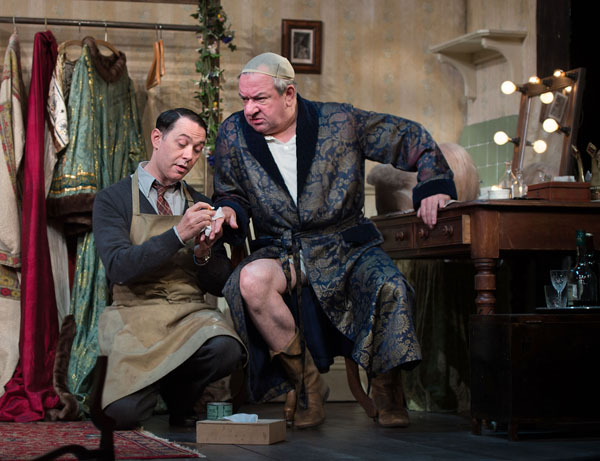The Dresser, Duke of York’s Theatre | reviews, news & interviews
The Dresser, Duke of York’s Theatre
The Dresser, Duke of York’s Theatre
Great work from Ken Stott and Reece Shearsmith saves a nostalgic drama

The best way to line up the stars is to offer them a chance to act in a play about the theatre. For this, Ronald Harwood’s The Dresser has a good track record: its original West End outing starred Tom Courtney; the 1983 film version had Albert Finney and Courtney again; and a 2015 BBC television version had Sirs Anthony Hopkins and Ian McKellen.
Sean Foley’s production is an apt celebration of the playwright’s 50-year career
Harwood worked as a dresser to Donald Wolfit, the mountainously individualistic Shakespearean actor-manager who died in 1968, although it would be a mistake to see this drama as a straight biography. Rather it is more like a fantasia, a love letter to a lost world where independent theatre companies, often third-rate and full of eccentrics and failures, toured the land, bringing the bard to the masses. Harwood sets The Dresser during wartime when the national emergency meant that most able-bodied actors were conscripted into the army so the companies had to recruit whoever was available. As morale-boosters, even ham actors and assorted incompetents could contribute to the Home Front.
During the first scene, set in Sir’s dressing room, we see how the dresser Norman (Shearsmith) tries desperately to get Sir (Stott) ready for the evening performance of King Lear. This is an uphill task because the great, if prematurely aged, actor-manager is suffered an extreme fit of stage-fright mixed with dementia and exhaustion and melancholy. Stott weeps, wails and stares around himself with an expression of acute bewilderment. Surely, say his wife – dubbed Her ladyship – and his stage manager Madge – a devoted spinster – he is no condition to go on? But Norman insists that Sir is okay, and helps him prepare his make-up, wig and lines.
Then the curtain of this fictional provincial venue rises, and so does the tension as King Lear begins, during an air raid of course, with Sir insisting that the show must go on. Harwood then explores life backstage in more detail, showing how Her Ladyship has suffered neglect by her monstrously selfish husband and boss, while Madge has also been exploited mercilessly. Irene, an aspiring young actress, is introduced for no very good reason except to show us the obvious: Sir likes to fondle nubile women. But although the play has a certain charm as a heartfelt evocation of Wolfitdom, Harwood never really manages to convince us that the crisis experienced by Sir is anything more than a crude device to rack up the tension.
 Sean Foley’s production, however, is finely directed and an apt celebration of the playwright’s 50-year career. Stott’s actor-manager is particularly commanding, his gravelly voice rising to a boom, the actorly consonants and vowels rolling around like waves beating against the shore, often giving the Luftwaffe’s thundering bombs a good run for their money. At one point, his face creases with radiant joy when Norman tells him that a full house awaits his performance. Likewise, Shearsmith’s dresser is a wonderful creation: part nagging nanny, part therapist and part colleague, he constantly suggests that there is more behind the facade of helpfulness – until the tragic last scene confirms this.
Sean Foley’s production, however, is finely directed and an apt celebration of the playwright’s 50-year career. Stott’s actor-manager is particularly commanding, his gravelly voice rising to a boom, the actorly consonants and vowels rolling around like waves beating against the shore, often giving the Luftwaffe’s thundering bombs a good run for their money. At one point, his face creases with radiant joy when Norman tells him that a full house awaits his performance. Likewise, Shearsmith’s dresser is a wonderful creation: part nagging nanny, part therapist and part colleague, he constantly suggests that there is more behind the facade of helpfulness – until the tragic last scene confirms this.
Foley marshals these performances, bringing out the play’s humour and adding numerous moments when a subtle exchange of looks speaks volumes. On Michael Taylor’s attractively squalid and detailed revolving set (pictured above), the supporting cast features Harriet Thorpe (Her Ladyship), Selina Cadell (Madge) and Phoebe Sparrow (Irene). While the in-jokes inevitable in a play about the theatre are often amusing, the main problem is that Harwood’s drama is frankly nostalgic, and must have been so even when it was first staged. But while the mystery of why Sir is breaking down is a great big hole at the centre of things, there is still a lot of pleasure to be had from seeing this version of the master and servant relationship, especially when it is so well acted by the principals.
rating
Share this article
The future of Arts Journalism
You can stop theartsdesk.com closing!
We urgently need financing to survive. Our fundraising drive has thus far raised £49,000 but we need to reach £100,000 or we will be forced to close. Please contribute here: https://gofund.me/c3f6033d
And if you can forward this information to anyone who might assist, we’d be grateful.

Subscribe to theartsdesk.com
Thank you for continuing to read our work on theartsdesk.com. For unlimited access to every article in its entirety, including our archive of more than 15,000 pieces, we're asking for £5 per month or £40 per year. We feel it's a very good deal, and hope you do too.
To take a subscription now simply click here.
And if you're looking for that extra gift for a friend or family member, why not treat them to a theartsdesk.com gift subscription?
more Theatre
 Punch, Apollo Theatre review - powerful play about the strength of redemption
James Graham's play transfixes the audience at every stage
Punch, Apollo Theatre review - powerful play about the strength of redemption
James Graham's play transfixes the audience at every stage
 The Billionaire Inside Your Head, Hampstead Theatre review - a map of a man with OCD
Will Lord's promising debut burdens a fine cast with too much dialogue
The Billionaire Inside Your Head, Hampstead Theatre review - a map of a man with OCD
Will Lord's promising debut burdens a fine cast with too much dialogue
 50 First Dates: The Musical, The Other Palace review - romcom turned musical
Date movie about repeating dates inspires date musical
50 First Dates: The Musical, The Other Palace review - romcom turned musical
Date movie about repeating dates inspires date musical
 Bacchae, National Theatre review - cheeky, uneven version of Euripides' tragedy
Indhu Rubasingham's tenure gets off to a bold, comic start
Bacchae, National Theatre review - cheeky, uneven version of Euripides' tragedy
Indhu Rubasingham's tenure gets off to a bold, comic start
 The Harder They Come, Stratford East review - still packs a punch, half a century on
Natey Jones and Madeline Charlemagne lead a perfectly realised adaptation of the seminal movie
The Harder They Come, Stratford East review - still packs a punch, half a century on
Natey Jones and Madeline Charlemagne lead a perfectly realised adaptation of the seminal movie
 The Weir, Harold Pinter Theatre review - evasive fantasy, bleak truth and possible community
Three outstanding performances in Conor McPherson’s atmospheric five-hander
The Weir, Harold Pinter Theatre review - evasive fantasy, bleak truth and possible community
Three outstanding performances in Conor McPherson’s atmospheric five-hander
 Dracula, Lyric Hammersmith review - hit-and-miss recasting of the familiar story as feminist diatribe
Morgan Lloyd Malcolm's version puts Mina Harkness centre-stage
Dracula, Lyric Hammersmith review - hit-and-miss recasting of the familiar story as feminist diatribe
Morgan Lloyd Malcolm's version puts Mina Harkness centre-stage
 Reunion, Kiln Theatre review - a stormy night in every sense
Beautifully acted, but desperately grim drama
Reunion, Kiln Theatre review - a stormy night in every sense
Beautifully acted, but desperately grim drama
 The Code, Southwark Playhouse Elephant review - superbly cast, resonant play about the price of fame in Hollywood
Tracie Bennett is outstanding as a ribald, riotous Tallulah Bankhead
The Code, Southwark Playhouse Elephant review - superbly cast, resonant play about the price of fame in Hollywood
Tracie Bennett is outstanding as a ribald, riotous Tallulah Bankhead
 The Lady from the Sea, Bridge Theatre review - flashes of brilliance
Simon Stone refashions Ibsen in his own high-octane image
The Lady from the Sea, Bridge Theatre review - flashes of brilliance
Simon Stone refashions Ibsen in his own high-octane image

Add comment